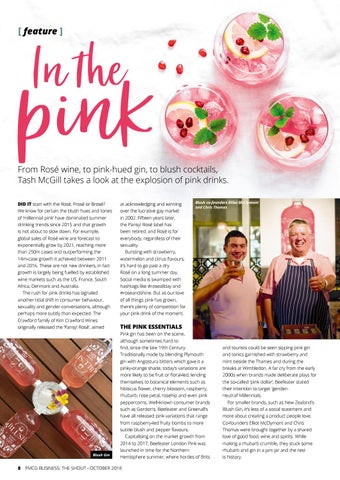[ feature ]
In the
pink
From Rosé wine, to pink-hued gin, to blush cocktails, Tash McGill takes a look at the explosion of pink drinks. DID IT start with the Rosé, Frosé or Brosé? We know for certain the blush hues and tones of ‘millennial pink’ have dominated summer drinking trends since 2015 and that growth is not about to slow down. For example, global sales of Rosé wine are forecast to exponentially grow by 2021, reaching more than 250m cases and outperforming the 14m-case growth it achieved between 2011 and 2016. These are not new drinkers, in fact growth is largely being fuelled by established wine markets such as the US, France, South Africa, Denmark and Australia. The rush for pink drinks has signaled another tidal shift in consumer behaviour, sexuality and gender conversations, although perhaps more subtly than expected. The Crawford family of Kim Crawford Wines originally released the ‘Pansy! Rosé’, aimed
Blush Gin
8
at acknowledging and winning over the lucrative gay market in 2002. Fifteen years later, the Pansy! Rosé label has been retired; and Rosé is for everybody, regardless of their sexuality. Bursting with strawberry, watermelon and citrus flavours, it’s hard to go past a dry Rosé on a long summer day. Social media is swamped with hashtags like #roseallday and #roseandshine. But as our love of all things pink has grown, there’s plenty of competition for your pink drink of the moment.
Blush co-founders Elliot McClymont and Chris Thomas
THE PINK ESSENTIALS Pink gin has been on the scene, although sometimes hard to find, since the late 19th Century. Traditionally made by blending Plymouth gin with Angostura bitters which gave it a pinky-orange shade, today’s variations are more likely to be fruit or floral-led, lending themselves to botanical elements such as hibiscus flower, cherry blossom, raspberry, rhubarb, rose petal, rosehip and even pink peppercorns. Well-known consumer brands such as Gordon’s, Beefeater and Greenall’s have all released pink variations that range from raspberry-led fruity bombs to more subtle blush and pepper flavours. Capitalising on the market growth from 2014 to 2017, Beefeater London Pink was launched in time for the Northern Hemisphere summer, where hordes of Brits
FMCG BUSINESS: THE SHOUT - OCTOBER 2018
and tourists could be seen sipping pink gin and tonics garnished with strawberry and mint beside the Thames and during the breaks at Wimbledon. A far cry from the early 2000s when brands made deliberate plays for the so-called ‘pink dollar’, Beefeater stated their intention to target ‘genderneutral’ Millennials. For smaller brands, such as New Zealand’s Blush Gin, it’s less of a social statement and more about creating a product people love. Co-founders Elliot McClymont and Chris Thomas were brought together by a shared love of good food, wine and spirits. While making a rhubarb crumble, they stuck some rhubarb and gin in a jam jar and the rest is history.
